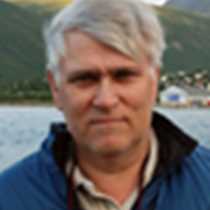Franz Josef Land
In the morning we sailed through Markham Sound, named after the famous president of the Royal Geographical Society in London. Later he was the man behind scenes for Robert Falcon Scott’s two voyages for the South, Antarctica. We also sailed along Newcomb Island, named after the Vice President of the National Geographic Society. It was named by the American explorer Walter Wellman, who made one of his many attempts to reach the North Pole by leaving from Franz Josef Land. His expedition in 1898-99 was sponsored by the National Geographic Society. He never got further than N82o, about the same latitude that National Geographic Explorer reached yesterday. In fact, of all four expeditions 1898 – 1905 heading for the Pole, three American and one Italian, by different explorers using Franz Josef Land as the hub for heading north, none ever came close the Pole. In fact, three were never able to get north of Rudolf Island! The only major outcome of Wellman’s expedition was to find the last major island and name it after the then-current President of the National Geographic Society, Alexander Graham Bell. Additionally he found and named more than 35 islands and capes.
Now we can call our epic voyage to Franz Josef Land: The second National Geographic expedition to Franz Josef Land, more than 100 years after Walter Wellman’s visit. For sure this is as close to an expedition we can ever come, a totally new area, for us mostly unknown conditions and in many ways pioneering every minute.
This morning as we reached Yermak Sound, northwest of Hayes Island, we got into more dense and almost perfect ice for polar bears. Soon one was sighted over a kill giving us remarkable insights into the polar bear life. Stefan followed up the sighting with his presentation about polar bears. After this, very few questions can be asked as he includes every piece in a polar bear’s life.
Also, while traveling inside the pack-ice, it is tough to find a more-true icon of the Arctic ice than the extreme “ice lover,” the Ivory Gull. It is the “ice gull” in many languages and is never found far from ice. The main world population is confined to a rather small area on the very southern edge of the Arctic Ocean, from Svalbard to Severnaya Zemlja. The smaller population in northeastern Canada is showing significant declines.
After lunch we tried several ways to penetrate further east but heavy drift ice blocked our ways. We ended up on the southern corner of Hayes Land where we embarked on a very cold and windy outing to watch walruses haul-out on a sandy spit. A few eider ducks and brent geese were also seen.
We continued to push east but again the ice made us turn around, but it also opened a new option — to land at Champ Island to enjoy a very strange geological feature, iron concentration, “rolling rocks” which are round “rock balls” some almost 2 meters in diameter. The size is unique for this site, but much smaller versions can also found in New Zealand and New Mexico. Our local geologist gave a good explanation for recap on how these strange features evolve in geological terms. After dinner we made more attempts to scan the pack-ice for “ice-depending” fury animals but soon we turned back to Markham Sound and set the goal for tomorrow, Rubini Rock at Hooker Island. Franz Josef Land is really the land of true adventures, ice, glaciers, huge bird cliffs, walruses…every day is full of new discoveries!




